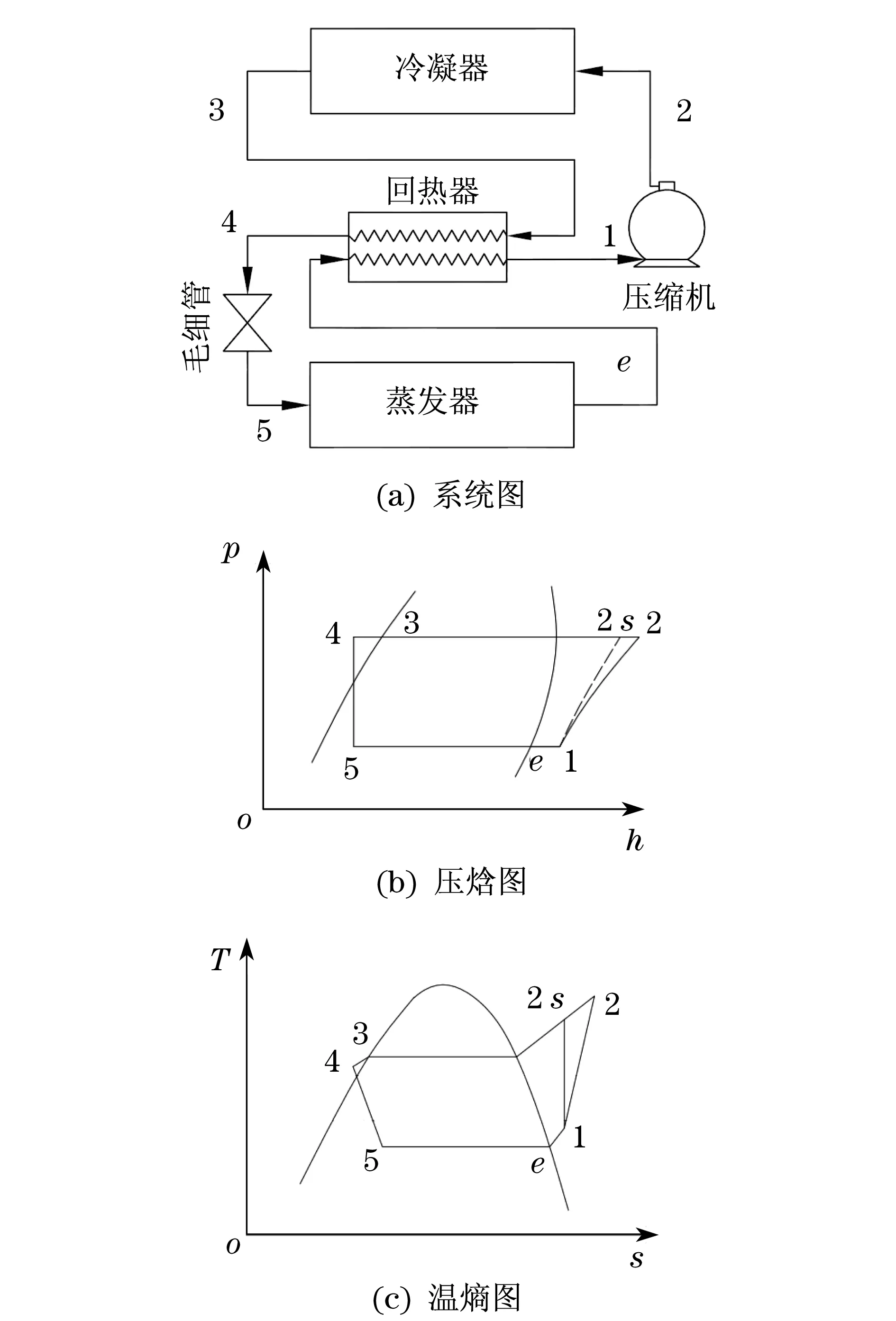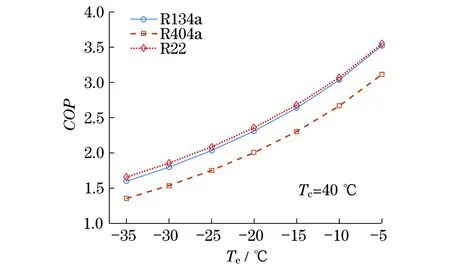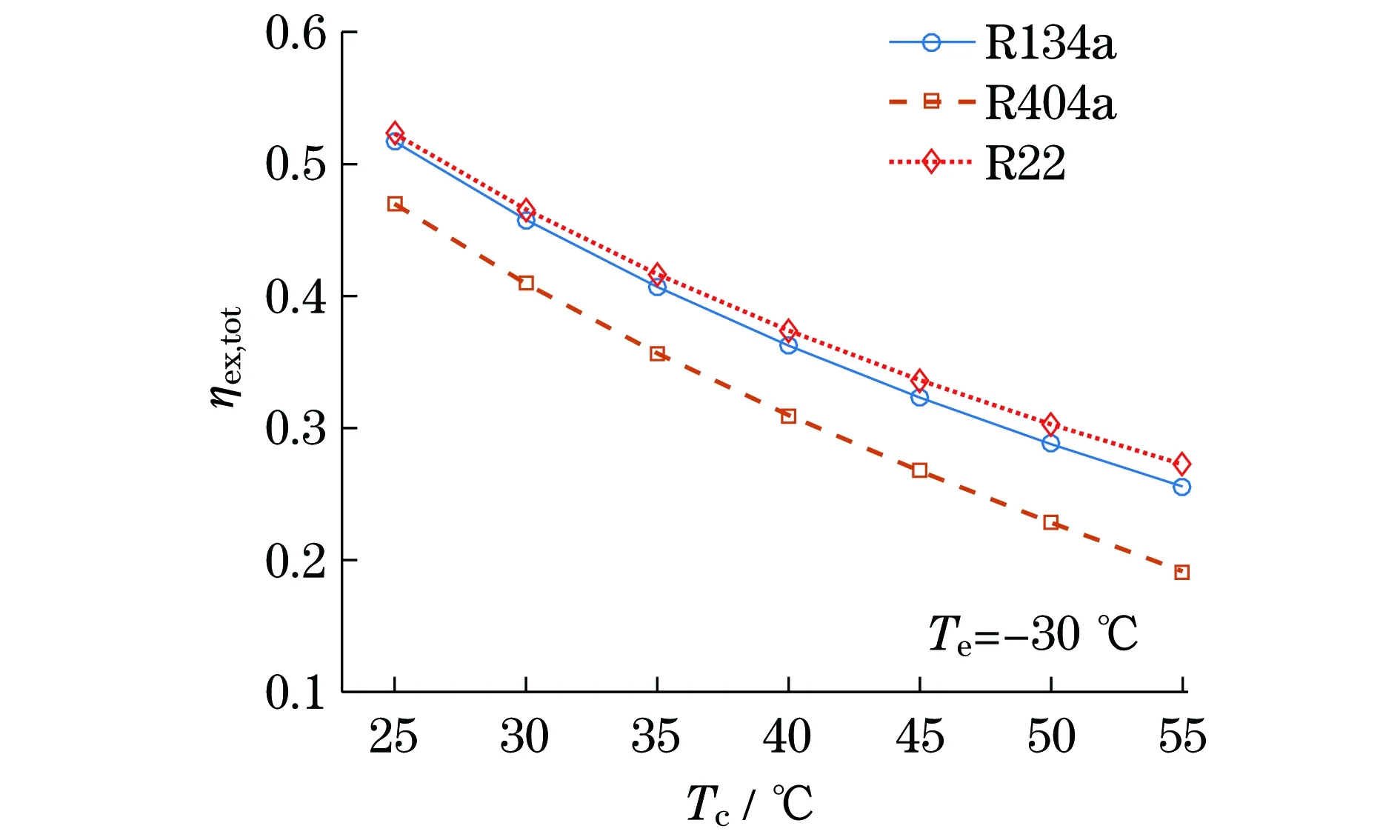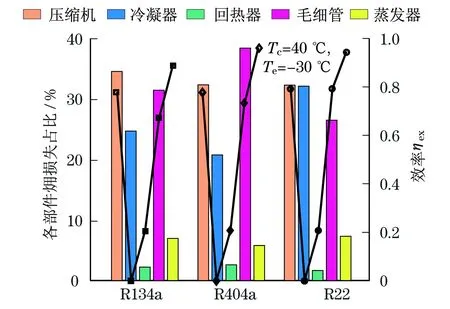冷冻消融预冷系统热力学分析
, , ,
(1.上海理工大学 能源与动力工程学院,上海 200093; 2.上海理工大学 医疗器械与食品学院,上海 200093)
冷冻消融预冷系统热力学分析
夏元通1,徐彬凯2,叶萍2,刘宝林2
(1.上海理工大学 能源与动力工程学院,上海200093;2.上海理工大学 医疗器械与食品学院,上海200093)


冷冻治疗因其具有无痛、微创、易恢复并可与其他治疗方式结合等优点[1-2],已成为外科手术的主要方法之一.其原理主要有两种:相变制冷和J-T (焦耳-汤姆逊)效应.由于相变制冷冷刀直径大、温度不易控制等缺点,在当前较为先进的冷冻手术中,已逐渐被气体节流冷刀所代替[3].但是,节流冷刀气体的工作压力大,氩氦刀氩气工作压力在20 MPa以上,风险高且不易推广.赵庆孝等[4]在氮气节流冷刀系统中加入预冷环节,不仅可以降低冷刀气体的工作压力,提高气体的有效利用率,同时可增大气体焓差,提高制冷量[4],现已成为J-T冷刀发展的新方向.预冷方式也因此成为研究内容之一,叶萍[5]研究了以热电制冷作为预冷方式实现从20 ℃至-40 ℃的预冷温度,分别对氮气和氩气冷刀的降温特性进行研究;于子淼等[6]设计了三级半导体制冷器对氮气冷刀进行预冷,并对该预冷方式作了深入研究;上海导向医疗系统有限公司为其靶向刀产品设计研发了多级自复叠预冷,率先实现了冷刀气体超低温预冷.

1 热力学分析

1.1循环描述
图1为设备采用的带回热器的蒸气压缩式制冷系统图以及循环的压焓图和温熵图.其中,1—2s表示压缩机等熵压缩过程,1—2表示实际压缩过程,3—4和e—1分别表示回热器内液体过冷和气体过热.p为压力,T为热力学温度,s为比熵,h为比焓.表1列出了循环的各项指标.

图1 带回热的单级蒸气压缩式制冷循环系统图、压焓图及温熵图

表1 循环各项指标Tab.1 Parameters of a refrigeration cycle
注:R134a制冷剂-30 ℃及以下部分仅用于理论计算,实际应用中无法达到.
由于制冷系统实际运行时的工况十分复杂,为简化分析,作如下假设[7-8]:
a. 系统各部件处于稳态条件下;
b. 除蒸发器与冷凝器外,制冷剂在连接管路内的压降及其与外界的热交换均为零;
c. 制冷剂在蒸发器和冷凝器内的压力不变;
d. 忽略制冷剂在系统内的动能和势能变化.
1.2理论模型


(1)
式中:qe为单位质量制冷量;wi为压缩机比功.


(2)
或者为[13]
(3)


压缩机
(4)
(5)
冷凝器
(6)
(7)
回热器
(8)

(9)
毛细管
(10)

(11)
蒸发器
(12)
(13)



(14)


(15)

(16)
2 分析讨论


图2 性能系数随蒸发温度的变化曲线(Tcon=40 ℃)Fig.2 Variation of COP with the change of evaporator temperature (Tcon=40 ℃)

图3 性能系数随冷凝温度的变化曲线(Tevap=-30 ℃)Fig.3 Variation of COP with the change of condenser temperature (Tevap=-30 ℃)

图4 总损失随蒸发温度的变化曲线(Tcon=40 ℃)Fig.4 Variation of total exergy destruction with the change of evaporator temperature (Tcon=40 ℃)
如图2和图3所示,3种制冷剂在所选工况下COP均随蒸发温度的升高而升高,随冷凝温度的升高而降低.这是因为蒸发温度上升,单位制冷量增加且压缩机耗功减少,导致COP增加.而冷凝温度升高,提高了压缩机的排气压力,使压缩机压比增大,导致压缩机效率降低,同时在蒸发器入口处,制冷剂的比焓提高,这意味着在给定工况下总的制冷量减小,导致系统COP减小.系统COP最大的为R22,R134a次之,R404a最小.在蒸发温度Te=-30 ℃,冷凝温度Tc=40 ℃时,R22与R134a制冷剂的COP比R404a制冷剂的分别大20.7%,17.0%,而此时R22的仅比R134a的大3.17%.蒸发温度由-5 ℃降低到-35 ℃时,R134a,R404a,R22这3种制冷剂的性能系数分别降低了54.7%,56.5%,53.4%,而冷凝温度由25 ℃升高到55 ℃时,COP分别降低了50.5%,59.2%,47.9%.R22降幅最小,说明随着蒸发温度与冷凝温度温差的增大,R22的性能要比R134a,R404a的优越.在相同制冷条件下,系统COP越大,产生的冷凝热相对越小,这对减小设备内温度非常重要.

图5 总损失随冷凝温度的变化曲线(Tevap=-30 ℃)Fig.5 Variation of total exergy destruction with the change of condenser temperature (Tevap=-30 ℃)

图6 总效率随蒸发温度的变化曲线(Tcon=40 ℃)Fig.6 Variation of total exergy efficiency with the change of evaporator temperature (Tcon=40 ℃)

图7 总效率随冷凝温度的变化曲线(Tevap=-30 ℃)Fig.7 Variation of total exergy efficiency with the change of condenser temperature (Tevap=-30 ℃)

图8 系统各部件损失占比(条形图)及其效率(折线图)Fig.8 Percentage (bar) of exergy destruction and exergy efficiency (line) in different components of system



3 结 论
单级蒸气压缩式制冷系统可实现氮气、氩气、二氧化碳、一氧化二氮等气体的预冷,是冷冻治疗系统的重要组成部分,其设计是否科学合理决定整个设备的品质.本文从能量利用的角度对其进行理论分析,为今后试验台搭建提供了方向性指导,也可作为其他相关制冷设备的理论参考.分析主要得出以下结论:
a. 在3种制冷剂中,R22各项性能最为优越,其次是R134a,最后是R404a.所以,R22是作为冷冻治疗设备预冷系统制冷剂的最佳选择.
b. 虽然R22环境友好程度不如R134a,但作为一种非常优秀的制冷剂,在未来相当长时间里仍可用于医疗行业.在所研究的各项指标中,R134a虽略逊R22,但差距不大,因此,在制冷剂限制比较严格的发达国家地区,可选用R134a作为替代.


[1] MIRKHALILI S M,RAMAZANI S A A,NAZEMIDASHTARJANDI S.Mathematical study of probe arrangement and nano-particle injection effects on heat transfer during cryosurgery[J].Computers in Biology and Medicine,2015,66:113-119.
[2] YU T H,LIU J,ZHOU Y X.Selective freezing of target biological tissues after injection of solutions with specific thermal properties[J].Cryobiology,2005,50(2):174-182.
[3] SHURRAB M,WANG H D,KUBO N,et al.The cooling performance of a cryoprobe:establishing guidelines for the safety margins in cryosurgery[J].International Journal of Refrigeration,2016,67:308-318.
[4] 赵庆孝,杨鹏飞,常兆华.新型超低温冷冻医疗系统的设计与实验研究[J].制冷学报,2009,30(6):57-60.
[5] 叶萍.乳腺肿瘤冷冻消融靶向治疗技术研究[D].上海:上海理工大学,2012.
[6] 于子淼,武卫东,姜博仁,等.基于半导体制冷预冷的氮气冷冻刀系统实验研究[J].低温工程,2014(1):50-54.
[7] AHAMED J U,SAIDUR R,MASJUKI H H.A review on exergy analysis of vapor compression refrigeration system[J].Renewable and Sustainable Energy Reviews,2011,15(3):1593-1600.
[8] RASTI M,AGHAMIRI S,HATAMIPOUR M S.Energy efficiency enhancement of a domestic refrigerator using R436A and R600a as alternative refrigerants to R134a[J].International Journal of Thermal Sciences,2013,74(6):86-94.
[9] ARORA A,KAUSHIK S C.Theoretical analysis of a vapour compression refrigeration system with R502,R404A and R507A[J].International Journal of Refrigeration,2008,31(6):998-1005.
[10] HUA Z Z,ZHANG H,LIU B L,et al.Refrigeration technology[M].Beijing:Science Press,2009.
[11] CHO H,PARK C.Experimental investigation of performance and exergy analysis of automotive air conditioning systems using refrigerant R1234yf at various compressor speeds[J].Applied Thermal Engineering,2016,101:30-37.
[12] YATAGANBABA A,KILICARSLAN A,KURTBA.Exergy analysis of R1234yf and R1234ze as R134a replacements in a two evaporator vapour compression refrigeration system[J].International Journal of Refrigeration,2015,60:26-37.
[13] YAN G,CUI C F,YU J L.Energy and exergy analysis of zeotropic mixture R290/R600a vapor-compression refrigeration cycle with separation condensation[J].International Journal of Refrigeration,2015,53:155-162.
[15] JOYBARI M M,HATAMIPOUR M S,RAHIMI A,et al.Exergy analysis and optimization of R600a as a replacement of R134a in a domestic refrigerator system[J].International Journal of Refrigeration,2013,36(4):1233-1242.
[16] DAYMA A S,AGRAWAL N,NANDA P.Energetic and exergetic analyses of a transcritical N2O heat pump system[J].International Journal of Low-Carbon Technologies,2014,9(4):277-283.
[17] DOOHAN R S,KUSH P K,MAHESHWARI G.Exergy based optimization and experimental evaluation of plate fin heat exchanger[J].Applied Thermal Engineering,2016,102:80-90.

[19] 郑贤德.制冷原理与装置[M].2版.北京:机械工业出版社,2008:68-70.
[20] YUMRUTAR,KUNDUZ M,KANOLU M.Exergy analysis of vapor compression refrigeration systems[J].Exergy,An International Journal,2002,2(4):266-272.
[21] 宋义乐.绝热节流过程的熵变特性分析[D].北京:华北电力大学,2013.
ThermodynamicAnalysisofSubcoolerinaCryoablationSystem
XIAYuantong1,XUBinkai2,YEPing2,LIUBaolin2
(1.SchoolofEnergyandPowerEngineering,UniversityofShanghaiforScienceandTechnology,Shanghai200093,China;2.SchoolofMedicalInstrumentandFoodEngineering,UniversityofShanghaiforScienceandTechnology,Shanghai200093,China)
The VCRS (vapor compression refrigeration system) was applied as a subcooler to obtain the needed temperature of a cryoablation system by J-T effect,and a mathematic model based on the first and second laws of thermodynamics was established for the energy and exergy analysis using R134a,R22 and R404a in the subcooling system of the cryoablation system.The effects of the evaporator and condenser temperatures on theCOP,total exergy destruction and total exergy efficiency of the system were investigated.The exergy destruction and exergy efficiency in different system components were also displayed.The R134a and R404a systems have lowerCOPand exergy efficiency but higher exergy destruction compared to the R22 system.However,the performance of R134a system is closer to the R22 system.So,the best refrigerant is R22 and R134a is a good alternative to R22.The major exergy destruction occurs in the compressor,condenser and capillary tube among all system components.The reasons and improvement suggestions were presented.
cryoablation;exergyanalysis;thermodynamics;subcoolingsystem
1007-6735(2017)05-0438-06
10.13255/j.cnki.jusst.2017.05.006
2017-03-02
浦东新区科技发展基金资助项目(PKJ2014-S16)
夏元通(1992-),男,硕士研究生.研究方向:低温生物医学技术.E-mail:wellxia@163.com
刘宝林(1968-),男,教授.研究方向:低温生物.E-mail:blliuk@163.com
TB61
A
(编辑:丁红艺)

